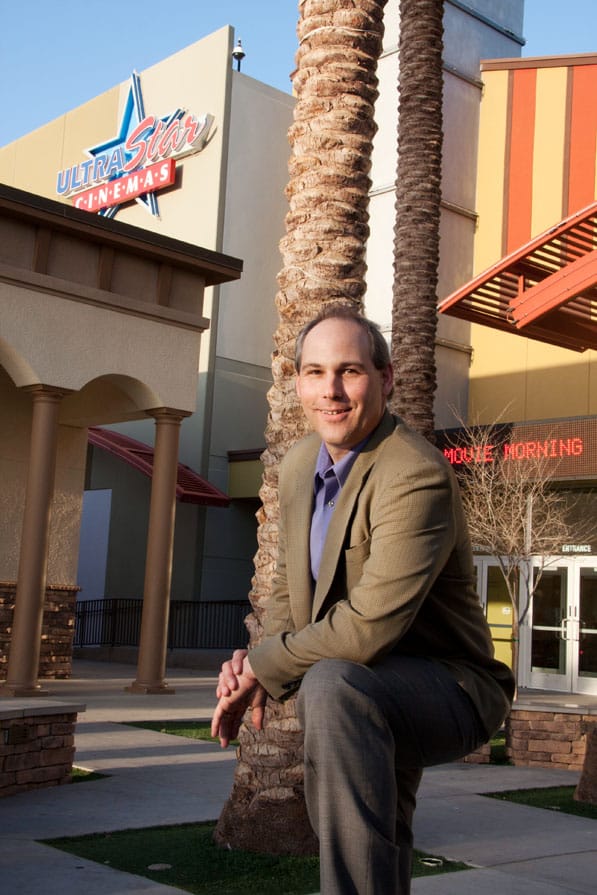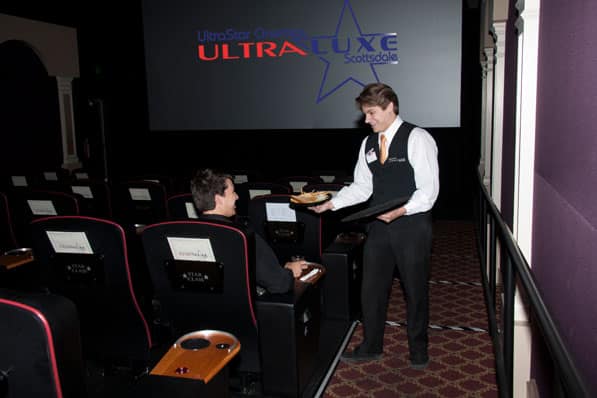
As an 18-year-old aspiring stagehand, Damon Rubio recalls answering a theater’s employment ad expecting a stage. He ended up selling popcorn in a cinema instead. Fast-forward 24 years later, however, and it’s all worked out for the best. Rubio stuck with the business and is now executive vice president of operations for UltraStar Cinemas, a chain of cinemas with 15 locations in California and Arizona. Rubio, who is of Portuguese descent, gives us a peek inside his multifaceted role, which includes everything from overseeing construction to choosing popcorn flavors.
This industry is in my blood. I studied live-theater production in college. I thought I’d work behind the scenes. When I got a job at a movie theater, I thought it would be temporary. As is the case with many people, however, I fell in love with the industry.
I’ve been at UltraStar for 12 years. As an independent regional movie-theater chain, we build theaters that service underserved markets. Our goal is to create a great moviegoing experience. We don’t want our guests treated like cattle; we want every moment of the experience—from choosing their movie to the drive out of the parking lot—to be enjoyable. Even if the movie isn’t as good as expected, the experience of going to the movie should be satisfying.
I wear a lot of hats. Because we’re a smaller company, we don’t have a lot of extra layers of management for every area of operations. So it’s my job to ensure that all the operation of the company continues to meet the moviegoers’ expectations. I’m also responsible for overseeing expansion opportunities and for looking at and assessing the value in new technology that could help improve moviegoers’ experience at our theaters.
We were the first chain in the nation to go 100 percent digital. For many years, that allowed us to have a better presentation than competitors because 35-millimeter film degrades each time it plays. Now our competitors are starting to roll out digital so we had to refocus on some of our core competitive advantages.
Our current competitive advantage is meeting guests’ needs. Moviegoers want a great presentation in a clean, comfortable environment that’s free of distractions. Our goal is to have a place where you don’t have to suffer through things like talking and texting, but if they occur, we’ll take care of it. We provide a lot of personal touches. Prior to every show, even if there’s only one person in theater, an employee welcomes guests and talks for a few moments about what they’re going to see. It adds a focus on the experience that differentiates us from many competitors.

We always want to expand our offerings. We’re building alternative moviegoing experiences. In some theaters, we offer the Star Class experience, which is only for moviegoers age 21 and over. You can watch a film without the distraction of children, and you can get a glass of wine or a beer. We also offer our D-Box [Technologies Inc] motion seats for the crowd who wants the thrill-ride experience. Because we offer numerous experiences, consumers know they can get what they want—whether they’re traditional moviegoers or a niche market.
The industry has always faced challenges. In the 1950s, we had a limited selection of entertainment options: three network stations, live theaters, and movies. Now, we have many other forms of entertainment competing for the consumer’s time. And it’s not as simple as home TV; there’s gaming on Xbox and Wii, time spent on Facebook and YouTube, easy streaming of music and video content on phones and tablets. All of those things have impacted and will continue to impact movie viewership.
The flip side is our industry has always met those challenges. Television was supposed to kill movies, as was, Betamax, cable, and the DVD. Those things have just made the industry change. We’ve had to improve our business so we can give consumers a reason to continue to come to the movies. That competition is good, because it keeps the industry fresh and innovative.
On The Agenda
Typical workday in the life of Damon Rubio
8 a.m. Review hundreds of e-mails
9 a.m. Check and analyze the grosses from the day before
10 a.m. Check in with department heads
11 a.m. Resolve any issues that arose the day before
2 p.m. Work on new projects, reviewing plans, and getting bids out
We’re currently expanding our offerings with the 109,000-square-foot Ak-Chin project in Maricopa, Arizona. In this location, we have a 12-screen theater with regular family environment, which includes 3-D and D-Box, as well 12 balcony levels for our Star Class level of service. Also, included in the complex are 24 lanes of bowling, a laser-tag arena, an arcade, a restaurant, and a bar and lounge with pool and shuffleboard. It’s a place you can find entertainment even if a movie isn’t on your agenda.
We’re also moving into China. We now have signed agreements with the Chinese city government of Tianjin to build and operate 200 theaters. One of the things that cemented the deal was our offer to build a university curriculum to train theater operators of tomorrow. Today, China doesn’t have a lot of people who understand how to operate a modern digital theater, which makes it hard to expand rapidly. In September, we will go to China to teach the first class, and we’ll bring students back to the United States with us to work in our theaters.
I think there will always be a place for movie theaters. At end of the day, people still want to go out and enjoy a social event. We just have to work harder at providing a better guest experience so when people do choose to spend their hard-earned cash on a night out at the movies, they come to an UltraStar cinema.

